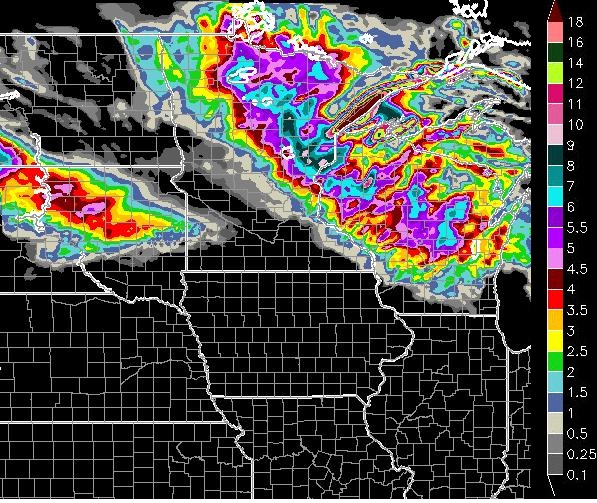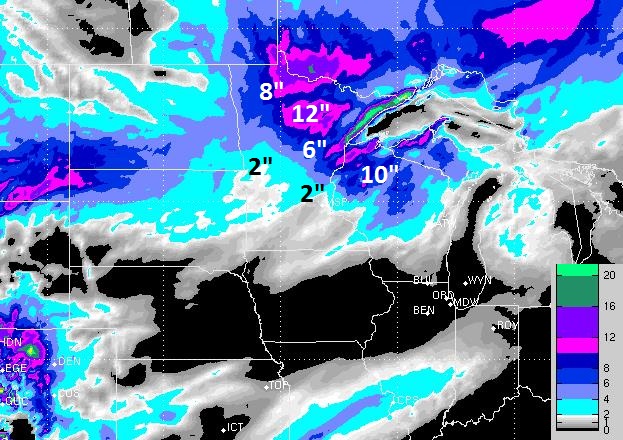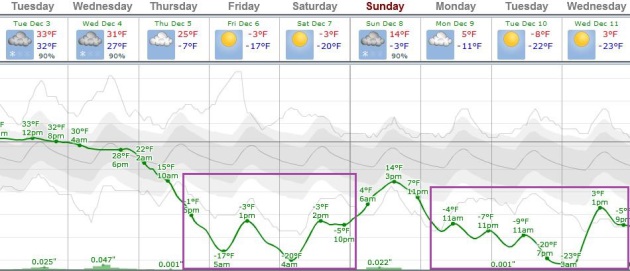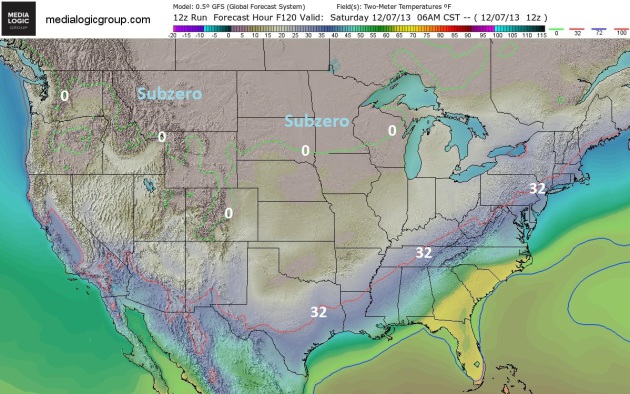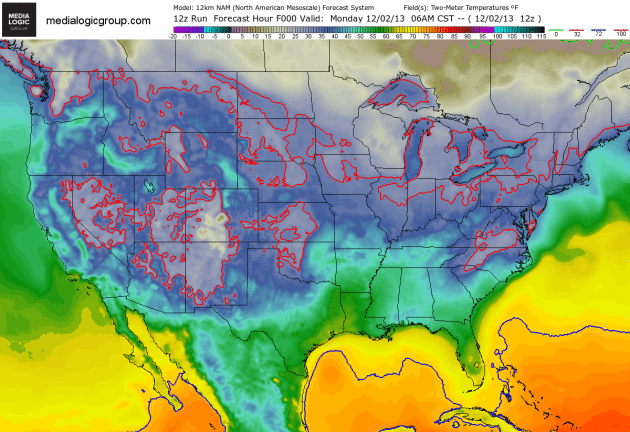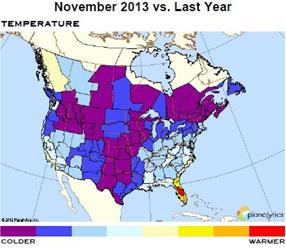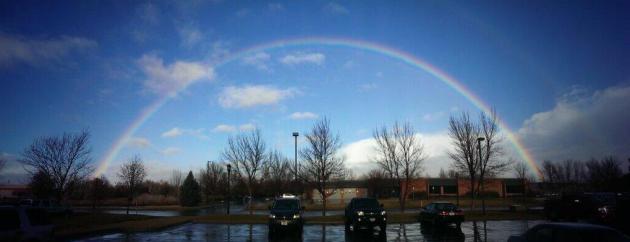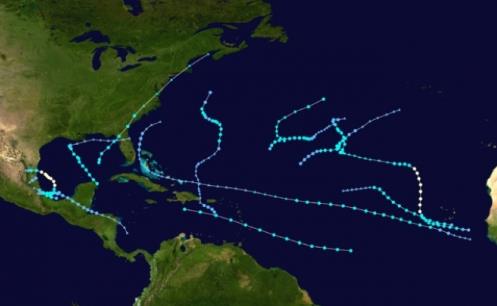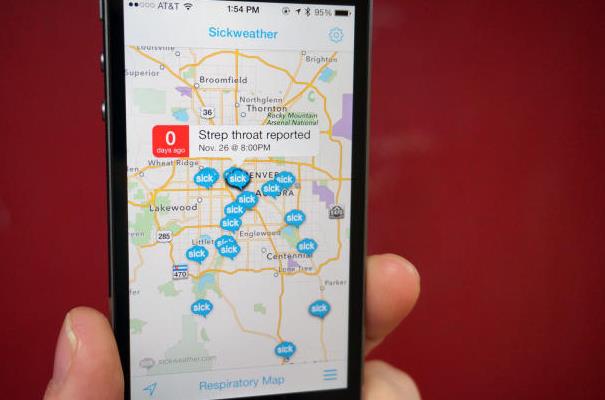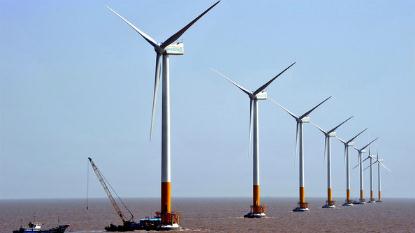 A Defining Chill
A Defining Chill
What
unites residents of Minneapolis, St. Paul and Duluth? Cheering on
Gophers, Twins, Vikes, Wolves and The Wild. And by The Wild I mean our
increasingly manic weather patterns.
What may turn into the
coldest arctic outbreak in a decade is on the way. Not a casual cold
front, but at least two separate waves of "Holy Thinsulate - get me out
of here!" Siberian Surges. An old fashioned cold wave spilling into
mid-December.
I'm predicting 5 subzero nights through the middle
of next week; in spite of a Yukon-blue sky daytime "highs" may not rise
above 0F on Saturday. Late week wind chills may dip to -25F or colder.
Bitter
blasts are often preceded by significant snow, and we're still on track
for some 4-14 inch snowfall amounts over central & northern
Minnesota by Thursday; maybe 2 feet along Lake Superior's North Shore.
Today
will offer a wintry mix, the rain-snow line hovering over MSP - rain
and sleet mixing with wet snow at times, mainly wet roads in the metro
area. As temperatures cool a changeover to snow is likely tonight, maybe
2-4" tonight into Wednesday - the best chance of 3 or 4" northern
suburbs. The farther north you drive up I-35 and 371 the heavier the
amounts, but enough warm air pushes north for a sloppy winter mix in the
metro today. ECMWF model data still hints at a few inches of snow
Wednesday in the metro.
Temperatures drop below 0F Thursday, and
may stay there until Sunday afternoon - before a reinforcing blast
arrives next week. Here we go!
Coldest Thanksgiving In 20 Years - Here Comes The Real Deal.
Last week's chill was just the appetizer; the main course comes later
this week, another Yukon punch early next week. Some slight moderation
is expected after December 15, but the next week to 10 days will leave
no doubt in your mind that winter has arrived. We track the cold wave,
and take a look back at a chilly Thanksgiving holiday, and why (many)
retailers were smiling in today's edition of
Climate Matters: "
WeatherNationTV
Chief Meteorologist Paul Douglas has a forecast for those that love
winter. Brutal Arctic chills, snow, and lots of it for much of the
northern tier of the United States. Also, just how does this
Thanksgiving stack up against previous ones?"
Snow By Midday Today.
The HopWRF shows significant snows setting up north and east of MSP, a
band of 6-9" from near Lake Mille Lacs to Cambridge, Taylors Falls to
Spooner, Wisconsin by noon today.
RPM Model.
WSI's 12km RPM model shows 2" of snow by Wednesday evening, with 4" far
northern suburbs - closer to 8-12" from Hibbing to Duluth.
WRF Total Accumulations.
A wintry mix is expected in the Twin Cities today; mainly wet, sloppy
roads with surface temperatures (just) above 32F, but snow will stick
30-75 miles north/east of MSP. WRF model total accumulations suggest
1-2" south metro, but as much as 3-5" northern suburbs, most of that
falling tonight into Wednesday. I suspect totals will range from 1--2"
south metro to 3-4" northern suburbs, with closer to 6-8" near Princeton
and Cambridge, maybe 4-7" in the St. Cloud area.
Ouch.
Other, more colorful words came to mind, but ouch will suffice for now.
What may be one of the coldest airmasses in a decade arrives late this
week, a second reinforcing smack of bitter air next week. The ECMWF
(above) may be overestimating the cold a bit, but I still expect
double-digit subzero lows Friday and Saturday morning, again a couple
days next week. Parts of central Minnesota could easily see lows in the
-20 to -30F range. I know, unreasonably cold.
Subzero Saturday?
By 6am Saturday the GFS shows the 0F isotherm near the Minnesota-Iowa
border. In spite of bright sun temperatures may not climb above 0F
Saturday afternoon, a rare subzero maximum at MSP. At least winds will
ease by then. Chill factors Thursday and Friday may dip to -20F in the
metro, -30 to -40 over parts of central and northern Minnesota. We're
about to get our cold weather bragging rights back.
Cold Wave.
Misery loves company, and as we take turns complaining about the chill,
at least least the rest of America will be whining right along with us.
The solid red line marks the 32F isotherm, the solid green line shows
the 0F temperature sagging southward by Thursday. If you have any
frequent flier miles you might want to consider cashing them in.
Quickly. NAM 12km guidance courtesy of NOAA and Ham Weather.
Coldest Thanksgiving Since 1993 for USA. Here's an excerpt of a report from
Planalytics - good shopping weather, it turns out: "...
Overall,
it was significantly colder than Thanksgiving Day last year, which was
the warmest since 1998. Across the entire U.S., the 2013 Black Friday
weekend (November 28 – December 1) was the coldest in 4 years. The
Mid-Atlantic, New England, and East North Central regions had their
coldest Black Friday weekend in over 15 years, and the South Atlantic
region was coldest since 2002. New York City, Baltimore, Pittsburgh,
Richmond, Charlotte, and New Orleans are just a few of the major markets
which had their coldest Black Friday weekend in over 15 years. Boston
was coldest since 2000, while Detroit, Cincinnati, Indianapolis,
Atlanta, Nashville, and Richmond were each coldest since 2002."
Coldest November Since 2000. Here's another timely clip from the weather analysts at Planalytics: "
In
the U.S., November 2013 was the coldest since 2000 and much colder than
normal. Precipitation and snowfall were both greater than last year,
although still below normal. Canada had its coldest November since 1996.
Rain and snowfall were both greater than last year, although below
normal.
- Thanksgiving was the coldest since 1993 and driest since 2002. The Black Friday Weekend was the coldest in 4 years. Several
major markets in the East had their coldest Black Friday weekend in
over 15 years, including NYC, Baltimore, Charlotte, and New Orleans.
Boston was coldest since 2000, Detroit and Atlanta since 2002, helping
put seasonal items in customer baskets.
- Week 4 in the U.S., which included Thanksgiving and Black Friday, was the coldest end to November in over 50 years. Canada was colder than normal..."
"...
Although
the first real snow of the season is [on the ground/ in the forecast],
the first signs of spring are already showing up in the time of sunset.
The sun is now within one minute of its earliest setting of the winter
season. This will come in less than a week, on Dec. 9, when the sun will
set at 4:31 PM. After that it sets later every day, reaching 4:41 PM by
New Years Eve and then 5 PM by Jan. 17. It's true that the shortest day
of the year is Dec. 21, but the December acceleration of the earth in
its orbit around the sun distorts the time of earliest sunset back to
Dec. 9. To compensate, the sun will be rising later every day until Dec.
30, when it's latest sunrise at 7:51 AM." - consulting meteorologist Dean DeHarpporte.
One Perfect Rainbow. Thanks to the Billings office of the National Weather Service (and
Twitter) for sharing this one.
Farmers Describe "Worst Storm In 150 Years". The freakish October blizzard that hit the Black Hills of South Dakota is still making news - here's a clip from
The BBC: "
Nearly
two months after devastating blizzards hit parts of South Dakota and
Wyoming, farmers are still recovering from the loss of cattle and the
effect on their businesses. The week before the storm, it had been wet
and mild and the prairies of the Great Plains were deep in mud. Then,
the first winter snow came early and unexpectedly in an icy blast from
the north-west. Trapped in the mud, 30,000 cattle suffocated and froze
to death. They were buried in 20ft (6m) snow drifts, entombed in ice in
what ranchers call the "breaks and draws" - the slopes and valleys - of
the rolling prairie hills..." (Photo: AP).
"Forecast Bust". Why 2013 Hurricane Predictions Were So Wrong. It was a season that left many tropical meteorologists scratching their heads.
NPR has the audio interview; here's an excerpt: "
Forecasters
expected the 2013 Atlantic hurricane season to be really busy — the
National Oceanic and Atmospheric Administration told Americans to expect
between seven and 11 hurricanes. But this year has been one of the
quietest on record. Why were the predictions so far off?"
Scientists Improve Models That Can Predict Killer Cyclone Surge.
Similarities between Haiyan's catastrophic storm surge in the
Philippines and the killer surge that hit Galveston, Texas in 1900?
Here's an excerpt of new research into storm surges at
E&E Publishing: "...
Tacloban's
surge was possibly the highest recorded in the Philippines, rivaling
the 24-foot surge record set in 1897, Needham noted. But in that surge,
the researcher saw more than a record. He saw a comparison. Needham is a
self-proclaimed "extreme weather" enthusiast, whose blog, Hurricane Hal's Storm Surge Blog,
analyzes present and past cyclones. His ability to run down historic
storm surges is similar to how a farmer can rattle off past bumper crops
and famine years..."
Photo credit above: "
The result of the storm surge that swept over Tacloban in the Philippines." Photo by Ton Carmello Pido Tallon.
Sydney Records Warmest Spring On Record. Weatherzone has the story - here's the introduction: "
Sydney
has recorded its warmest spring on record, largely due to a fiery
September and October. The combined minimum and maximum for the New
South Wales capital of 19.9 degrees for spring comfortably broke the
previous record of 19.5 degrees set in 1988. The average maximum of 24.7
degrees smashed the previous record set in 2002 of 24.2 degrees..."
Sickweather Tracks, Then Alerts You Of Nearby Illnesses. Yes, there's even an app for that - reports of flu and other bugs surrounding your neighborhood or GPS location.
CNET has more details: "...
Download the free Sickweather app from the App Store,
designate which viruses and conditions you want to be alerted of, and
let the app do the rest. By scanning social networks for mentions of
specific illnesses while filtering out redundant phrases or random uses
of the word "sick" (and the like), Sickweather is able to plot where the
plague has occurred on a map. When you approach an area marked on the
map, you'll receive an alert of the illness and when it was last
reported..."
Image credit above:
Jason Cipriani/CNET.
Four Auto Features That Make Driving Easier For The Elderly. Nice photo selection for this article. Wow. What is that, a Model T?
Business Insider Australia has the story - here's a clip: "
Driving
as a senior citizen can be hard: According to AAA, nearly 90% of
drivers 65 and older suffer from health issues that affect their ability
to drive safely. But as I learned when I put on a crazy suit to see what it’s like to drive as an 80-year-old man, there are lots of features that can make things easier..."
Dear Santa - Please Don't Screw Up The URL.
I do this with my wife, to make sure I get the right size and color,
and now kids have caught on in their pleas to Santa. Or is it a
promotional device for Amazon? Details from Yahoo News.
Climate Stories....
"
The
problem is that enough people aren’t willing to change their own
behaviors or pay to support an aggressive anti-emissions program right
now. That’s not simply because of oil-company lobbying. It’s because
fossil fuels are cheap. They are abundant, energy-rich and easy to
transport." -
Editorial, Washington Post.
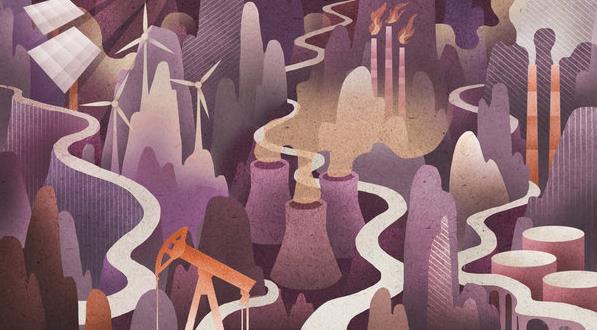
Power In 2030 - The Roads We May Take. Daniel Yergin, who has written extensively about energy and oil, has a very interesting Op-Ed in
The New York Times,
focused on America's energy mix going forward, a smooth transition
toward less polluting and renewable fuels, or a vortex of pain? Here's
an excerpt: "...
How, then, to assess the energy future? One way is
through the use of scenarios. These are not meant to be predictions or
forecasts, but rather plausible ‘‘stories’’ about the future. They help
to identify what seems to be predetermined, the things you can count on.
They also highlight the driving forces and big uncertainties — and
even the potential surprises before they occur. The scenarios below are
written from the vantage point of 2030. Drawing on work that I oversaw
at the research firm IHS, of which I am vice chairman, I propose three
futures: ‘‘Global Redesign,’’ ‘‘Meta’’ and ‘‘Vortex.’’ Each is quite
plausible but leads to very different balances between conventional
energy — oil, natural gas and coal — and renewables like solar and
wind..."
Image credit: Eion Ryan.
Sports Bigs Step Up On Climate Change - And They're Not Tree Huggers. Here's an excerpt of a story at
The New York Daily News: "...
But
here was husky Craig Harnett, the NHL’s chief financial officer,
talking about ponds on which many players grew up no longer freezing.
“To the extent it becomes more difficult to create ice, you’re limiting
access. Already in this country, there is not enough access to ice
time.” He detailed league involvement with new HVAC systems in arenas
and on-site renewable energy. Similarly, some MLB stadiums use
solar-panel systems and wind turbines to reduce their carbon footprints.
The NFL will be planting 27,000 trees, managing food recovery and
taking other environmentally mindful steps in the lead up to and after
February’s Super Bowl in New Jersey..."
Something In The Weather Tells Us Climate Change Is Real.
Yes, as I've been describing for 15 years the Symphony of Seasons is
playing out of tune - the patterns have shifted. Here's a clip of an
Op-Ed at
The St. Louis Post Dispatch that caught my eye: "...
I
suspect that nearly everyone who reads this knows deep inside that
something isn’t right with the weather. Science has been telling us for
decades what “isn’t right.” The atmosphere has too much carbon and it’s
trapping more heat, like a thicker blanket over the earth. My dad taught
me something else very important and this explains why I spoke to the
Environmental Protection Agency, why I give talks in the community and
why I’m writing this letter. He taught me to do the right thing. It’s
time for all of us “to do the right thing” and listen to what we all
know deep down to be true. The evidence is overwhelming — which is why
climate scientists worldwide now are 95 percent confident climate change
is manmade. Not one major scientific body in the world disputes it. And
don’t forget the threat the Pentagon sees..."
How Do Meteorologists Fit Into The 97% Global Warming Consensus? The author of this story at
The Guardian
accurately describes the vast majority of AMS members as
meteorologists, not climate scientists, which is absolutely true. Here's
an excerpt: "...
The AMS on the other hand is not comprised primarily of climate experts. Some of its members do climate research, but only 13 percent of survey participants
described climate as their field of expertise. Among those respondents
with climate expertise who have published their climate research, this
survey found that 93 percent agreed that humans have contributed
significantly to global warming over the past 150 years (78 percent said
it's mostly human-caused, 10 percent said it's equally caused by humans
and natural processes, and 5 percent said the precise degree of human
causation is unclear, but that humans have contributed). Just 2 percent
of AMS climate experts said global warming is mostly natural, 1 percent
said global warming isn't happening, and the remaining 4 percent were
unsure about global warming or human causation..."
Tech Leaders, Economists Split Over Clean Energy's Prospects. Here's a clip of a story from
NPR: "...
Kammen
thinks advances in technology are on the horizon that could push the
United States rapidly away from fossil fuels. If we put a price on the
environmental damage caused by carbon dioxide, clean forms of energy
like solar would become comparatively cheaper, he says. That would
trigger a whole new relationship between people and energy, he says, as
homeowners produce power instead of simply consuming it. People would
have a powerful reason to install solar panels and store some of that
energy in the batteries in their electric cars — and even send short
bursts of it to the power grid..."


